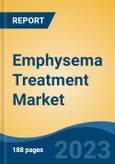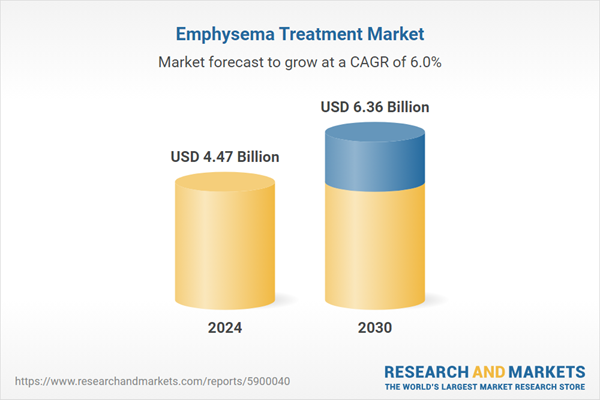Speak directly to the analyst to clarify any post sales queries you may have.
10% Free customizationThis report comes with 10% free customization, enabling you to add data that meets your specific business needs.
Pharmaceutical and medical device companies are actively developing innovative therapies, including long-acting bronchodilators, biologics, and minimally invasive procedures like lung volume reduction surgery (LVRS) and endobronchial valve implantation. The shift toward personalized treatment strategies is improving patient outcomes by tailoring interventions based on disease severity and individual response to therapy. The expansion of home healthcare solutions, including portable oxygen therapy devices and digital respiratory monitoring tools, is enhancing disease management and supporting market growth.
Ongoing research into regenerative medicine and gene-based therapies is transforming the treatment landscape by exploring potential disease-modifying solutions. The development of targeted anti-inflammatory and regenerative therapies aims to slow disease progression and improve lung function. Biopharmaceutical companies are focusing on monoclonal antibodies and stem cell therapies as emerging treatment avenues. The integration of artificial intelligence (AI) in diagnostics and disease monitoring is enabling early detection and more precise intervention, reducing complications. Companies are investing in pipeline expansion through collaborations and clinical trials, with an emphasis on improving treatment efficacy and reducing adverse effects. The emphasis on combination therapies, incorporating bronchodilators, anti-inflammatory drugs, and pulmonary rehabilitation programs, is enhancing comprehensive disease management and driving product innovation.
Key Market Drivers
Advancements in Medical Technology
Advancements in medical technology are significantly enhancing the global emphysema treatment market. Emphysema, a debilitating form of chronic obstructive pulmonary disease (COPD), has historically been challenging to manage. However, recent technological breakthroughs are transforming emphysema care.Minimally invasive procedures, such as bronchoscopic lung volume reduction (BLVR), have become pivotal in emphysema treatment. BLVR involves the insertion of devices like endobronchial valves to occlude diseased lung regions, thereby improving respiratory function. Clinical studies have demonstrated that BLVR can enhance lung performance and quality of life in selected patients. For instance, research indicates that BLVR procedures have shown promising outcomes in improving lung function and exercise capacity among patients with advanced emphysema.
The development of biologics and targeted therapies marks another significant advancement in emphysema management. These treatments aim at specific molecular pathways that contribute to disease progression, potentially decelerating emphysema's advancement and enhancing pulmonary function. This targeted approach offers a more effective and less invasive alternative to traditional therapies.
Key Market Challenges
High Treatment Costs
High treatment costs are a significant barrier hindering the advancement of the Global Emphysema Treatment Market. Emphysema, a debilitating chronic obstructive pulmonary disease (COPD), affects millions of individuals worldwide, and managing this condition can be financially burdensome for both patients and healthcare systems.The development of innovative emphysema treatments, such as bronchoscopic lung volume reduction (BLVR) procedures and targeted biologics, has offered new hope to patients by providing potentially more effective and less invasive options. However, these cutting-edge treatments often come with a hefty price tag.
For many emphysema patients, the high cost of treatment represents a substantial financial barrier. Coping with the financial burden of these therapies can be overwhelming, particularly for those without comprehensive health insurance coverage. High deductibles, copayments, and out-of-pocket expenses can strain patients' finances and limit their access to essential treatments.
Additionally, emphysema is a chronic condition that often requires ongoing care, including medications, regular check-ups, and pulmonary rehabilitation. These long-term expenses further compound the financial challenges faced by patients, potentially forcing them to make difficult choices between healthcare and other essential needs.
The burden of high treatment costs also extends to healthcare systems and governments. As the prevalence of emphysema continues to rise, the strain on healthcare budgets becomes more pronounced. The cost of providing advanced treatments and therapies can lead to allocation challenges, diverting resources from other critical healthcare needs.
Key Market Trends
Adoption of Minimally Invasive Procedures
The adoption of minimally invasive procedures is playing a pivotal role in boosting the Global Emphysema Treatment Market. Emphysema, a progressive lung condition characterized by the destruction of lung tissue, has traditionally been associated with invasive surgical treatments or long-term medication. However, recent advancements in medical technology have led to the development and widespread adoption of minimally invasive procedures, offering a paradigm shift in the way emphysema is treated.One of the most significant contributors to the growth of minimally invasive procedures is the emergence of bronchoscopic lung volume reduction (BLVR) techniques. BLVR involves the insertion of small devices or materials into the airways to block or reduce airflow to damaged lung areas. This procedure aims to improve lung function and alleviate symptoms without the need for open surgery. Patients benefit from shorter hospital stays, faster recovery times, and reduced risk of complications compared to traditional surgical approaches.
The appeal of minimally invasive procedures goes beyond their effectiveness; it lies in their patient-centric approach. Patients are more inclined to opt for less invasive treatments that offer quicker recovery times and a lower risk of complications. As a result, healthcare providers increasingly recommend and perform BLVR and other minimally invasive procedures, meeting the preferences and expectations of patients.
Moreover, the adoption of minimally invasive procedures aligns with the broader trend in healthcare toward value-based care and cost-effectiveness. These procedures typically lead to reduced healthcare costs due to shorter hospital stays and less post-operative care, benefiting both patients and healthcare systems.
Key Market Players
- Icure Pharmaceuticals Inc.
- AstraZeneca Plc.
- Teva Pharmaceuticals Industries Ltd.
- Novartis AG
- GlaxoSmithKline Plc.
- Hikma Pharmaceuticals Plc
- Boehringer Ingelheim International GmbH
- Mylan N.V.
- Pfizer Inc.
- Orion Corporation
Report Scope:
In this report, the Global Emphysema Treatment Market has been segmented into the following categories, in addition to the industry trends which have also been detailed below:Emphysema Treatment Market, By Treatment:
- Smoking Cessation
- Bronchodilators
- Steroids
- Leukotriene Modifiers
- Supplemental Oxygen
- Antibiotics
- Gene Therapy
- Surgery Transplant
- Other Treatments
Emphysema Treatment Market, By Distribution Channel:
- Hospital Pharmacy
- Retail Pharmacy
- Other Distribution Channels
Emphysema Treatment Market, By End-User:
- Hospitals & Clinics
- Ambulatory Surgical Centers
- Others
Emphysema Treatment Market, By Region:
- North America
- United States
- Canada
- Mexico
- Europe
- France
- United Kingdom
- Italy
- Germany
- Spain
- Asia-Pacific
- China
- India
- Japan
- Australia
- South Korea
- South America
- Brazil
- Argentina
- Colombia
- Middle East & Africa
- South Africa
- Saudi Arabia
- UAE
Competitive Landscape
Company Profiles: Detailed analysis of the major companies present in the Global Emphysema Treatment Market.Available Customizations:
With the given market data, the publisher offers customizations according to a company's specific needs. The following customization options are available for the report.Company Information
- Detailed analysis and profiling of additional market players (up to five).
This product will be delivered within 1-3 business days.
Table of Contents
Companies Mentioned
- Icure Pharmaceuticals Inc.
- AstraZeneca Plc.
- Teva Pharmaceuticals Industries Ltd.
- Novartis AG
- GlaxoSmithKline Plc.
- Hikma Pharmaceuticals Plc
- Boehringer Ingelheim International GmbH
- Mylan N.V.
- Pfizer Inc.
- Orion Corporation
Table Information
| Report Attribute | Details |
|---|---|
| No. of Pages | 182 |
| Published | March 2025 |
| Forecast Period | 2024 - 2030 |
| Estimated Market Value ( USD | $ 4.47 Billion |
| Forecasted Market Value ( USD | $ 6.36 Billion |
| Compound Annual Growth Rate | 6.0% |
| Regions Covered | Global |
| No. of Companies Mentioned | 10 |









